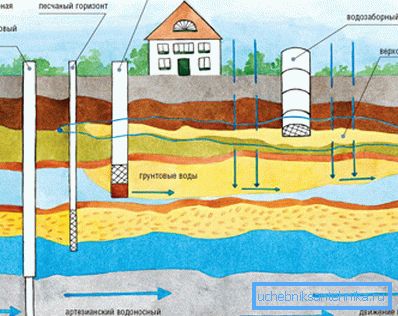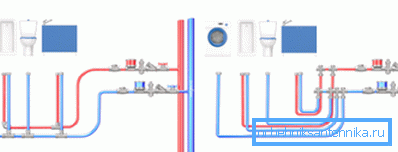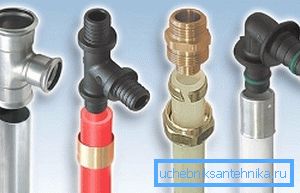Laying plumbing in a private house: how to make it as
It is rather difficult to equip the water supply system in a country house, but it is quite possible. If you follow the recommendations of experts and construction rules, the system will work properly for many years.

Water sources
First of all you need to think about the source of water.
- He must provide for each of the residents of the house 30/50 liters of water per day.
- When equipping the building with a modern flush sewage system, shower, bath, the resource consumption per person rises 3 times.
- For watering plants will need, at least, 5 l / m ?.
Types of water intake sources

- Centralized water supply is connected to the communal system of the village.
- Autonomous analogue uses water from an individual source on the site. It can be a well, a well, a spring, a river, etc.
Note! Autonomous water intake should be located not less than 20 m from latrines. The same goes for septic tanks, cesspools and compost heaps.
If parallel installation of a cable with a water supply system is carried out, the distance from it to the pipes should be at least 10 cm. Wires laid in parallel with the hot pipeline should be protected from high temperatures.
Connection to the communal highway
- The easiest way to connect a private water supply to the central water supply network.
- For this we need to conclude an agreement with the local "Vodokanal".
- In the issued permit, the conditions for connecting to the system and using the resource will be indicated.
- Before the construction of the aqueduct you will be given a drawing of the location of the object to which you will need to connect, recommend the best method of laying pipes.
Autonomous water supply
- It is more rational to dig a well or punch a hole near the house. So you reduce the expenditure of pipes.
- If a drainage device is put in place (for summer water supply not used in winter), it should be located below the soil freezing depth.
- From this mark depends on the depth of the plumbing in a private house. It is necessary when digging a trench for the installation of an external network section.
- The network should be laid with a slope (about 3/5 mm per 1 meter of pipes). It will ensure complete discharge of water at the end of the season.
- At the end of the external section of the water supply, it is necessary to install a drain bar with a rotary handle or a shut-off valve.
Typical network device

Autonomous supply network is a combination of external and internal parts.
Their elements are such structures, devices and equipment.
- Water source, which includes equipment for lifting and pumping resource (submersible or surface pumps).
- Filtering devices for coarse and fine cleaning of liquids.
- Supply system (piping, shut-off valves, storage and water-pressure tanks).
- Heating appliances.
- Automatic equipment control.
- Consumers of water: sinks, wash basins, bath, shower, etc.
The pressure in the autonomous water supply is provided by a pumping station or a water tower. For this purpose, an overpass with a height of 3/4 m is mounted, a metal or plastic tank is placed on it.
External part of the system

- Based on the seasonality of operation (only in summer or all year round), the external part of the network can be partly laid in a trench or mounted using an open method.
- When laying underground, pipes should be installed with a slope to the water intake structure. The depth of laying should be 20 cm below the level of soil freezing on the site.
- The network, laid on the ground or above the mark of its freezing, should be wrapped with insulation.
Internal water supply

The first step is to draw a diagram. It is needed to calculate the cost of materials and to mount the network without errors. Simple drawings and calculations will allow not to transfer structures or to change equipment because of their size, which do not fit into the particular area.
The correct device and the competent scheme of laying water supply system in a private house consists of the following.
- Pipeline
- Water metering if the system is connected to a centralized highway.
- Points of consumption and the devices installed on them.
- Water heaters, if hot water is provided.
- Regulating and stop valves.
- Dilution network.

If you have state-approved schemes in your hands, you need to verify them with the realities on the site, and then follow them strictly. If there are no technical documents, make your own working drawings. The plan should show to scale all elements of the network, their location and configuration.
It is best to wall up the water pipes in the walls or hide them with facing, bearing structures. Open installation of the network in your own home is made when other options are not possible.
Note! It is desirable to reduce the maximum length of the pipeline, as well as the number of bends and joints - most often they are the cause of leakage. Right angles reduce the pressure in the system, and therefore are also not very desirable.
Which pipes to choose

The instruction says that it is advisable to choose water pipes that are light but durable. In addition, they must be resistant to chemicals and temperature extremes.
Based on this, plastic products are now the most popular:
- HDPE polyethylene analogs (low pressure polyethylene);
- polypropylene pipes (PP);
- polyvinyl chloride products (PVC);
- plastic and aluminum pipes.
The main advantages of polymer pipes are as follows.
- Even a person who is not particularly versed in plumbing can cope with their installation without any problems.
- Network mates are very strong, almost monolithic, using a special type of soldering (if PE and PP pipes are used).
- Polymer tubes can be bent. This minimizes the number of dangerous, in terms of potential accidents, sites and points.
- Often, welding of joints can be avoided by connecting the network elements with the help of combined fittings with metal inserts.
- Among the main advantages of polymer pipes - an excellent level of rigidity and torsional strength. This is especially valuable if the electric pump built into the system develops a strong torque.
Note! Plastic pipes should not be fixed to the walls or ceiling with rigid supports. They are recommended to use for filters, valves, valves and counters.
For the polymer pipeline itself, sliding supports are best suited. Their step should be one meter. In areas where it is not possible to install them, annular compensators are placed for every 3 meters of the network.
System installation

- The internal structure of the system consists of pipe wiring to water consuming points.
- It does not matter what the complexity and price of the system is, wiring it inside the house should begin with the installation of shut-off valves of the risers. They are needed for emergency and repair network outages.
- The pipeline should be laid with a slope of 3 mm per meter network, in the direction of the risers.
- Metal-plastic parts of the system should be mated with crimp-type fittings. (another name - compression fittings), monolithic plastic elements - by soldering.
Note! If the plumbing will include electrical equipment, it is necessary to take care of its grounding and lightning protection. All wiring must be additionally protected from moisture.
Conclusion
It is possible to equip the water supply system in your own house on your own. It should be warned - it is not so simple. The main thing here - to follow all the norms of construction and the requirements of specialists.
The video in this article will assist you in finding more information.